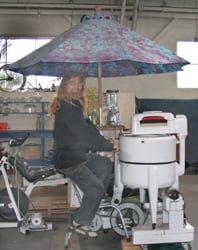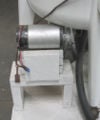
The Pedal Powered Washing Machine. Designed and Built by Bart Orlando / Assisted by Dana Papke
-
Bart Orlando demonstrates that one person has the power to wash clothes in a pedal powered Wringer washing machine. The wringer eliminates the spin dry function, standard on modern washing machines. One person can do 1/3 of a normal load of laundry in about 30 minutes
-
An exercise bike is substituted for the original 2hp 110v electric motor. A fan-belt is rapped around the flywheel of the exercise bike and a pulley which drives the original transmission of the Wringer Washer.
-
This version of the pedal powered washing machine features the addition of a pedal powered permanent magnet electric generator that can supply electricity to a 110v blender. The female end of an AC extension cord is wired to the positive and negative leads from the DC generator. The generator output is approximatley 110 volts-DC at 1100 rpm, while pedaling at about 90 rpm. Most household blenders have universal motors that run both AC or DC.
-
This article appeared in the HSU Lumberjack newspaper in 1997. The article is based on an interview with the pedal powered washing machine designer, Bart Orlando. Since then, the pedal power drive line of the washer has been simplified. The number of fanbelts used has been reduced from two belts to one belt. Now, one fanbelt connects the flywheel of the exercise bike directly to the pulley which drives the transmission of the washer. This reduces the amount of friction by eliminating one belt and two pillow blocks. Less friction translates into less pedaling effort.
-
This CAD diagram of the pedal powered washing machine was made by Matt Rhode as a class assignment for a course he took at HSU in computer assisted drawing in 2000. Students taking that course are incouraged by the instructor to choose CCAT's pedal powered devices for the subjects of their CAD drawing assignments. In this way, the engines of the university are harnessed to advance the work of CCAT. This diagram, of the CCAT pedal powered washer (designed by Bart Orlando), was submitted to Home Power magazine in 2001.
-
When Arcata became the first city in the United States to elect a city council with a majority of Green Party members, People magazine printed an article which featured this photo of the CCAT pedal powered washing machine.





